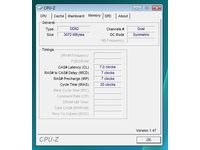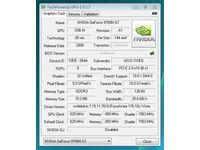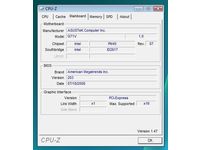SLI & Centrino 2: Gaming Laptops Battle
ASUS G71 Republic Of Gamers: Hardware
ASUS’ notebooks have come a long way. In fact, the company is the sixth largest vendor in North America, last we checked, with aspirations of a top-three spot. Not long ago, ASUS laptops were much like the Clevo designs we’re looking at today—colored neutrally and fairly generic. But the G71 Republic of Gamers design is decidedly bolder.
Processor
We’d expect a notebook with the word Gamer in its name to include some fairly high-end hardware. For the most part, ASUS does not disappoint. The G71 platform itself supports the latest quad-core QX9300—a 2.53 GHz Penryn with 12 MB of L2 cache on a 1,066 MHz bus. Of course, it’ll also do a dual-core Core 2 Extreme X9100 or lower-end Core 2 Duo T9000-, P8000-, or P7000-series chip. Our sample came with a Core 2 Duo T9400, released in July 2008.


Next to a lineup of Core 2 Extremes and desktop quad-cores, ASUS’ T9400 looks a bit underpowered. However, the chip is still quite capable. It runs at 2.53 GHz on a 1,066 MHz bus (with a 9.5x multiplier), yet still sips just 35W. From a raw specs angle, the T9400 looks a lot like the medium-voltage P9500 at 25 W, so we’re expecting great things from this chip in the battery life tests to make up for its slight clock speed deficiency.
Memory
The G71 is a Centrino 2 design centering on Intel’s PM45 chipset. So, while CPU-Z reports that the G71 is sporting 3 GB of DDR2 at an unknown clock speed, there is actually 4 GB of Qimonda DDR3 running at 1,333 MHz.
Naturally, since CPU-Z was unable to successfully identify the modules’ type, we were also leery of trusting its claim that our DDR3 was running 7-7-7 timings. A quick reference with Qimonda reveals the real timings are 8-8-8, though it is worth noting that the memory vendor does sell DDR3-1333 modules with 9-9-9 timings, making ours the more performance-oriented. Kudos to ASUS for its enthusiast nod.
Get Tom's Hardware's best news and in-depth reviews, straight to your inbox.
Graphics
Here’s where the G71 is going to come up short versus the other contenders in this roundup. Instead of two—or even one—flagship graphics chip driving its gaming performance, the Republic of Gamers system includes a GeForce 9700M GT discrete adapter. It doesn’t sound like a far cry from Nvidia’s GeForce 9800M GT found in the Alienware and Eurocom notebooks we’re testing here, but the 9700M only sports 32 unified shaders (versus 96) and eight ROPs. Naturally, the GPU itself is completely different—a G96M, similar only in that it’s manufactured at 65nm.


Like the G92M found in Alienware’s m17x, ASUS’ G96M is driven by 512 MB of GDDR3, albeit on a 128-bit bus rather than a 256-bit connection. As a result, theoretical memory bandwidth is slashed to 25.6 GB/s. This notebook’s graphics muscle is understandably only a fraction of what you’d find on one of the competing platforms.
To be fair, ASUS is not yet a major presence in the mobile gaming market, and the G71 looks to be its fastest offering yet. We’re expecting good things from it in the productivity tests, but expectations should be tempered for our gaming benchmarks.
Storage
The G71 chassis boasts two hard drive bays, each able to take a 2.5” SATA disk. Our sample came armed with a pair of Western Digital Scorpio Blues with 250 GB of capacity each. Though the drives only support SATA 1.5 Gb/s (a good thing when it comes to power consumption) and spin at 5,400 RPM, they’re put together in a RAID 0 array and manage to outperform the array of 5,400 RPM drives in Alienware’s Area-51 setup. We still have our reservations about RAID 0 on the road, but the G71 didn’t give us any of reliability issues seen on the Alienware or Killer Notebooks configurations.
Could our issues be related to the ICH7-M controller found on those other systems, fixed with the PM45’s ICH9-M? Perhaps—neither the ASUS nor the Eurocom Centrino 2 systems ran into storage problems.
Networking
Given its Centrino 2 pedigree, we’d expect to see the G71 with Intel’s new wireless controller cards. And indeed, it does come with the WiFi Link 5100. But while the 5100 supports 802.11a/g/draft-n, it only boasts one send and one receive antenna, limiting throughput to 300 Mb/s. Though that’s not bad at all, the other Centrino 2 offering in this roundup, Eurocom’s Montebello, includes the potentially-faster WiFi Link 5300. Fortunately, the 5100 enables the other benefits proffered by the latest Intel wireless products—mainly, power savings and Active Management support.
Of course, Gigabit Ethernet is also a standard piece of ASUS’ latest enthusiast notebook.
Chassis/LCD
The 17” G71 is available with two different LCD screens: one features WXGA+ resolutions and the other sports WUXGA dimensions of 1920x1200. Straight-on, the higher-end display looks quite sharp. But as we moved from one side to the other, creating more acute viewing angles, certain areas of the screen appeared “hotter” than others, making those regions unreadable. We didn’t encounter this on any of the other notebooks.
ASUS’ chassis is of the company’s own design with a handful of unique extras. There isn’t any I/O up front—just a release for the two clasps that keep the lid closed. The left and right sides are surprisingly free of visible ports as well. But it’s all cleverly hidden. To the left, you’ll see a DVD+/-R/RW combo drive that mounts flush with the rest of the notebook, along with a card reader plugged up with a plastic blank. An inconspicuous red door further up the side seems to be held in place magnetically. Behind that door you’ll find a pair of USB 2.0 ports and a FireWire 400 mini-jack. On the other side, you have an ExpressCard bay and on/off switch for the wireless controller. A similarly-placed magnetic door hides two more USB ports and audio I/O. The rest of the G71’s connectivity is on the notebook’s backside. There’s an HDMI output, an eSATA port, VGA-out, Gigabit Ethernet, and the system’s modem jack. Though we’d consider the back to be the least convenient place for all of those connectors, the Gigabit port is probably the only one likely to be used often.


The G71 includes a 5,200 mAh battery, which isn’t as large as the Alienware or Killer Notebooks power plants. But because ASUS’ offering employs lighter-weight hardware and Intel’s Centrino 2 platform, we expect it to show more impressive battery run time results.
Current page: ASUS G71 Republic Of Gamers: Hardware
Prev Page Alienware’s m17x: Look and Feel Next Page ASUS G71 Republic Of Gamers: Look And Feel-
kitsilencer From a money point of view, it's never going to make sense buying a gaming laptop. Scaled down performance and inability to upgrade are issues.Reply
But it sure as hell feels good having one ^___^ -
neiroatopelcc http://www.tomshardware.com/reviews/gaming-notebook-roundup,2023-6.htmlReply
"shipped the system with a 64-bit copy of Vista Ultimate (Alienware included x32 Home Premium)." -
ap90033 4 Grand? Are you guys nuts? I would say that right there would rule out about 90% of us normal gmaers..Reply
Besides the gaming scores looked weak imo..
I personally thought it was a better idea to go get a Gateway P7811FX with a single Geforce 9800GTS. It plays Call of Duty at 1920x1200 max settings around 50FPS. AND it cost me ONLY $1249 (Plus Best Buy let me pick any game I wanted for FREE!) -
agree with kitsilencer, gaming laptop is never practical.Reply
even with a beast graphics card, you'd be pretty hard to get more than 2 hours of shitty performance.
get a gaming desktop and perhaps an EEE or iPhone for travelling. my iPhone has 20+ games and enough media (don't forget TV connector for watching films in hotels) to keep me busy for more than one week away from my gaming rig. -
ap90033 Not true my "Gmaing Laptop" is great at LAN Parties and I play it for 6-8 Hours straight there...Reply
I think maybe you had a bad experience with a laptop that claimed to be a "gaming" laptop. I bought one before like that and it have an 8600M Geforce and it Sucked bad... If you get a good laptop with say a 9800gts or so you would be suprised... -
GlItCh017 ap900334 Grand? Are you guys nuts? I would say that right there would rule out about 90% of us normal gmaers..99.90%Reply -
ap90033 PS gaming laptops hold value much better than desktops. I had one I paid 1250 for, had it for a year, then sold it for $1100 and bought the newer "upgraded" model that just came out for $1250. I got an Upgraded CPU (From Core 2 1.67 GHZ to Core 2 Centrino 2 2.26 GHZ), Memory (from 3 Gigs DDR2 667MHZ to 4 Gigs DDR3 1066MHZ), Hard Drive (faster), Video Card (from 8800gts to 9800GTS), Screen (from 1440x800 to 1920x1200) and OS (From 32 bit to 64 bit). Not bad upgrade for $150 or so!Reply
